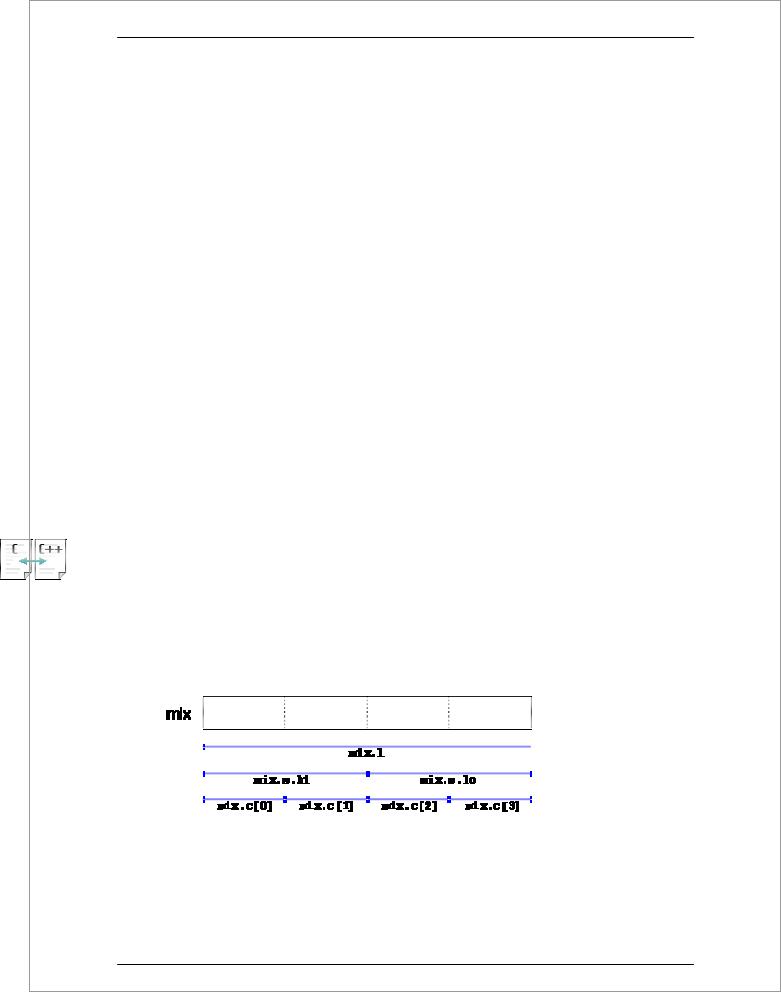
AhmadLang / Object Oriented Programing using C++
.pdf
Object Oriented Programming using C++
// array of structures |
Enter title: Alien |
#include <iostream.h> |
Enter year: 1979 |
#include <stdlib.h> |
Enter title: Blade Runner |
|
Enter year: 1982 |
#define N_MOVIES 5 |
Enter title: Matrix |
|
Enter year: 1999 |
struct movies_t { |
Enter title: Rear Window |
char title [50]; |
Enter year: 1954 |
int year; |
Enter title: Taxi Driver |
} films [N_MOVIES]; |
Enter year: 1975 |
void printmovie (movies_t movie); |
You have entered these movies: |
|
Alien (1979) |
int main () |
Blade Runner (1982) |
{ |
Matrix (1999) |
char buffer [50]; |
Rear Window (1954) |
int n; |
Taxi Driver (1975) |
for (n=0; n<N_MOVIES; n++) |
|
{ |
|
cout << "Enter title: "; |
|
cin.getline (films[n].title,50); |
|
cout << "Enter year: "; |
|
cin.getline (buffer,50); |
|
films[n].year = atoi (buffer); |
|
} |
|
cout << "\nYou have entered these movies:\n"; |
|
for (n=0; n<N_MOVIES; n++) |
|
printmovie (films[n]); |
|
return 0; |
|
} |
|
void printmovie (movies_t movie) |
|
{ |
|
cout << movie.title; |
|
cout << " (" << movie.year << ")\n"; |
|
} |
|
Pointers to structures
Like any other type, structures can be pointed by pointers. The rules are the same as for any fundamental data type: The pointer must be declared as a pointer to the structure:
struct movies_t { char title [50]; int year;
};
movies_t amovie; movies_t * pmovie;
Here amovie is an object of struct type movies_t and pmovie is a pointer to point to objects of struct type movies_t. So, the following, as with fundamental types, would also be valid:
pmovie = &amovie;
Ok, we will now go with another example, that will serve us to introduce a new operator:
// pointers to structures |
Enter title: Matrix |
#include <iostream.h> |
Enter year: 1999 |
#include <stdlib.h> |
You have entered: |
|
|
struct movies_t { |
Matrix (1999) |
char title [50]; |
|
int year; |
|
}; |
|
71

Object Oriented Programming using C++
int main ()
{
char buffer[50];
movies_t amovie; movies_t * pmovie; pmovie = & amovie;
cout << "Enter title: "; cin.getline (pmovie->title,50); cout << "Enter year: "; cin.getline (buffer,50); pmovie->year = atoi (buffer);
cout << "\nYou have entered:\n"; cout << pmovie->title;
cout << " (" << pmovie->year << ")\n";
return 0;
}
The previous code includes a new important introduction: operator ->. This is a reference operator that is used exclusively with pointers to structures and pointers to classes. It allows us not to have to use parenthesis on each reference to a structure member. In the example we used:
movies->title
that could be translated to:
(*movies).title
both expressions movies->title and (*movies).title are valid and mean that we are evaluating the element title of the structure pointed by movies. You must distinguish it clearly from:
*movies.title
that is equivalent to
*(movies.title)
and that would serve to evaluate the value pointed by element title of structure movies, that in this case (where title is not a pointer) it would not make much sense. The following panel summarizes possible combinations of pointers and structures:
|
|
|
|
|
Expression |
|
Description |
|
Equivalent |
|
|
|
|
|
movies.title |
|
Element title of structure movies |
|
|
|
|
|
|
|
movies->title |
|
Element title of structure pointed by movies |
|
(*movies).title |
|
|
|
|
|
*movies.title |
|
Value pointed by element title of structure movies |
|
*(movies.title) |
|
|
|
|
|
Nesting structures
Structures can also be nested so that a valid element of a structure can also be another structure.
72

Object Oriented Programming using C++
struct movies_t { char title [50]; int year;
}
struct friends_t { char name [50]; char email [50];
movies_t favourite_movie; } charlie, maria;
friends_t * pfriends = &charlie;
Thus, after the previous declaration we could use the following expressions:
charlie.name maria.favourite_movie.title charlie.favourite_movie.year pfriends->favourite_movie.year
(where, by the way, the last two expressions are equivalent).
The concept of structures that has been discussed in this section is the same used in C language, nevertheless, in C++, the structure concept has been extended up to the same functionality of a class with the peculiarity that all of its elements are considered public.
User defined data types
We have already seen a sort of data type that is defined by the user (programmer): the structures. But moreover than these there are other sorts of user defined data types:
Definition of own types (typedef).
C++ allows us to define our own types based on other existing data types. In order to do that we shall use keyword typedef, whose form is:
typedef existing_type new_type_name ;
where existing_type is a C++ fundamental or any other defined type and new_type_name is the name that the new type we are going to define will receive. For example:
typedef char C;
typedef unsigned int WORD; typedef char * string_t; typedef char field [50];
In this case we have defined four new data types: C, WORD, string_t and field as char, unsigned int, char* and char[50] respectively, that we could perfectly use later as valid types:
C achar, anotherchar, *ptchar1; WORD myword;
string_t ptchar2; field name;
typedef can be useful to define a type that is repeatedly used within a program and it is possible that we need to change it in a later version, or if a type you want to use has a too long name and you want it to be shorter.
73

Object Oriented Programming using C++
Unions
Unions allows a same portion of memory to be accessed as different data types, being in fact all of them the same location in memory. Its declaration and use is similar to the one of structures but its functionality is totally different:
union model_name { type1 element1; type2 element2; type3 element3;
.
.
} object_name;
All the elements of the union declaration occupy the same space of memory. Its size is the one of the greatest element of the declaration. For example:
union mytypes_t { char c;
int i; float f;
} mytypes; defines three elements:
mytypes.c
mytypes.i
mytypes.f
each one of a different data type. Like all of them are referring to a same location in memory the modification of one of the elements will afect to the value of all of them.
One of the uses a union may have is to unite an elementary type with an array or structures of smaller elements. For example,
union mix_t{ long l; struct {
short hi; short lo; } s;
char c[4]; } mix;
defines three names that allow us to access the same group of 4 bytes: mix.l, mix.s and mix.c and which we can use according to how we want to access it, as long, short or char respectively. I have mixed types, arrays and structures in the union so that you can see the different ways how we can access to the data:
Anonymous unions
In C++ we have the option that unions be anonymous. If we include a union in a structure without any object name (the one that goes after the curly brackets { }) the union will be anonymous and
74

Object Oriented Programming using C++
we will be able to access to the elements directly by its name. For example, look at the difference between these two declarations:
union |
anonymous union |
struct { |
struct { |
char title[50]; |
char title[50]; |
char author[50]; |
char author[50]; |
union { |
union { |
float dollars; |
float dollars; |
int yens; |
int yens; |
} price; |
}; |
} book; |
} book; |
The only difference between the two pieces of code is that in the first one we gave a name to the union (price) and in the second not. The difference is when accessing to members dollars and yens of an object. In the first case it would be:
book.price.dollars
book.price.yens
whereas in the second it would be:
book.dollars
book.yens
Once again I remind you that because it is a union, the fields dollars and yens occupy the same space in the memory so they cannot be used to store two different values, that means that you can include a price in dollars or yens but not both.
Enumerations (enum)
Enumerations serve to create data types to contain something different that is not limited neither to numerical or character constants nor constants true and false. Its form is the following:
enum model_name { value1,
value2, value3,
.
.
} object_name;
For example, we could create a new type of variable called color to store colors with the following declaration:
enum colors_t {black, blue, green, cyan, red, purple, yellow, white};
Notice that we do not include any fundamental data type in the declaration. To say it somehow we have created a new data type without being based on any other existing one: the type color_t, whose possible values are the colors that we have enclosed within curly brackets {}. For example, once declared the colors_t enumeration the following expressions will be valid:
colors_t mycolor;
mycolor = blue;
if (mycolor == green) mycolor = red;
75

Object Oriented Programming using C++
In fact our enumerated data type is compiled as an integer and their possible values are any type of integer constant specified. If this one is not specified, the integer value equivalent to the first possible value is 0 and the following ones follow a +1 progression. Thus, in our data type colors_t that we defined before, white would be equivalent to 0, blue would be equivalent to 1, green to 2 and so on.
If we explicitly specify an integer value for some of the possible values of our enumerated type (for example the first one) the following values will be the increases of this, for example:
enum months_t { january=1, february, march, april, may, june, july, august,
september, october, november, december} y2k;
in this case, variable y2k of the enumerated type months_t can contain any of the 12 possible values that go from january to december and that are equivalent to values between 1 and 12, not between 0 and 11 since we have made january to be equal to 1.
Classes
A class is a logical method to organize data and functions in a same structure. They are declared using keyword class, whose functionality is similar to the one of the C keyword struct, but with the possibility of including functions as members, moreover than only data.
Its form is:
class class_name { permission_label_1:
member1; permission_label_2:
member2;
...
} object_name;
where class_name is a name for the class (user defined type) and the optional field object_name is one, or several, valid object identifiers. The body of the declaration can contain members, that can be either data or function declarations, and optionally permission labels, that can be any of these three keywords: private:, public: or protected:. They make reference to the permission which the following members acquire:
∙private members of a class are accessible only from other members of its same class or
from its "friend" classes.
∙protected members are accessible, in addition to from members of the same class and
friend classes, also from members of its derived classes.
∙Finally, public members are accessible from anywhere where the class is visible.
If we declare members of a class before including any permission label the members they are considered private, since it is the default permission that the members of a class declared with the class keyword acquire.
For example:
class CRectangle { int x, y;
public:
void set_values (int,int);
76

Object Oriented Programming using C++
int area (void); } rect;
Declares class CRectangle and an object called rect of this class (type). This class contains four members: two variables of type int (x and y) in the private section (because private is the default permission) and two functions in the public section: set_values() and area(), of which we have only included the prototype.
Notice the difference between class name and object name: In the previous example, CRectangle was the class name (i.e., the user-defined type), whereas rect was an object of type CRectangle. Is the same difference that int and a have in the following declaration:
int a;
int is the class name (type) and a is the object name (variable).
On successive instructions in the body of the program we can refer to any of the public members of the object rect as if they were normal functions or variables, just by putting the object's name followed by a point and then the class member (like we did with C structs). For example:
rect.set_value (3,4); myarea = rect.area();
but we will not be able to refer to x nor y since they are private members of the class and they could only be referred from other members of that same class. Confused? Here is the complete example of class CRectangle:
// classes example |
area: 12 |
#include <iostream.h> |
|
class CRectangle { |
|
int x, y; |
|
public: |
|
void set_values (int,int); |
|
int area (void) {return (x*y);} |
|
}; |
|
void CRectangle::set_values (int a, int b) { |
|
x = a; |
|
y = b; |
|
} |
|
int main () { |
|
CRectangle rect; |
|
rect.set_values (3,4); |
|
cout << "area: " << rect.area(); |
|
} |
|
The new thing in this code is the operator :: of scope included in the definition of set_values(). It is used to declare a member of a class outside it. Notice that we have defined the behavior of function area() within the definition of the CRectangle class - given its extreme simplicity. Whereas set_values() has only its protype declared within the class but its definition is outside. In this outside declaration we must use the operator of scope ::.
The scope operator (::) allows to specify the class to which the member being declared belongs to, granting exactly the same scope properties as if it was directly defined within the class. For example, in the function set_values() of the previous code, we have resorted to the variables x and y, that are members of class CRectangle and that are only visible inside it and its members (since they are private).
77

Object Oriented Programming using C++
The only difference between defining a class member function completely within its class and to include only the prototype, is that in the first case the function will automatically be considered inline by the compiler, while in the second it will be a normal (not-inline) class member function.
The reason why we have made x and y private members (remember that if nothing else is said all members of a class defined with keyword class have private access) it is because we have already defined a function to introduce those values in the object (set_values()) and therefore the rest of the program does not have why to access directly to them. Perhaps in a so simple example as this one you do not see a great utility protecting those two variables, but in greater projects it may be very important that values cannot be modified in an unexpected way (unexpected way, from the point of view of the object).
One of the greater advantages of classes is that we can declare several different objects from it. For example, following with the previous example of class CRectangle, we could have declared the object rectb in addition to the object rect :
// class example |
rect area: 12 |
#include <iostream.h> |
rectb area: 30 |
class CRectangle { |
|
int x, y; |
|
public: |
|
void set_values (int,int); |
|
int area (void) {return (x*y);} |
|
}; |
|
void CRectangle::set_values (int a, int b) { |
|
x = a; |
|
y = b; |
|
} |
|
int main () { |
|
CRectangle rect, rectb; |
|
rect.set_values (3,4); |
|
rectb.set_values (5,6); |
|
cout << "rect area: " << rect.area() << endl; |
|
cout << "rectb area: " << rectb.area() << endl; |
|
} |
|
Notice that does not give the same result the call to rect.area() than the call to rectb.area(). To explain it somehow, each object of class CRectangle has its own variables x and y, and its own functions set_value() and area().
On that is based the concept of object and object-oriented programming. In that data and functions are properties of the object, instead of the usual view of objects as function parameters in structured programming. In this and the following sections we will discuss advantages of this methodology.
In this concrete case, the class (type of object) to which we were talking about is CRectangle, of which there are two instances, or objects: rect and rectb, each one with its own member variables and member functions.
Constructors and destructors
Objects generally need to initialize variables or to assign dynamic memory during their process of creation to become totally operative and to avoid returning unexpected values during their
78

Object Oriented Programming using C++
execution. For example, what would happen if in the previous example we called the function area() before having called function set_values? Probably an indetermined result since the members x and y would have never been assigned a value.
In order to avoid that, a class can include a special function: a constructor, which can be declared by naming a member function with the same name as the class. This constructor function will be called automatically when a new instance of the class is created (when declaring a new object or allocating an object of that class) and only then. We are going to implement CRectangle including a constructor:
// classes example |
rect area: 12 |
#include <iostream.h> |
rectb area: 30 |
class CRectangle { |
|
int width, height; |
|
public: |
|
CRectangle (int,int); |
|
int area (void) {return (width*height);} |
|
}; |
|
CRectangle::CRectangle (int a, int b) { |
|
width = a; |
|
height = b; |
|
} |
|
int main () { |
|
CRectangle rect (3,4); |
|
CRectangle rectb (5,6); |
|
cout << "rect area: " << rect.area() << endl; |
|
cout << "rectb area: " << rectb.area() << endl; |
|
} |
|
As you can see, the result of this example is identical to the previous one. In this case we have only replaced the function set_values, that no longer exists, by a class constructor. Notice the way in which the parameters are passed to the constructor at the moment at which the instances of the class are created:
CRectangle rect (3,4);
CRectangle rectb (5,6);
You can also see how neither the prototype nor the later constructor declaration include a return value, even no void type, this must always be thus. A constructor never returns a value nor the void has to be specified. Right how we have not done in the previous example.
The Destructor fulfills the opposite functionality. This is automatically called when an object is released from the memory, either because its scope of existence has finished (for example, if it was defined as a local object within a function and the function ends) or because it is an object dynamically assigned and is released using operator delete.
The destructor must have the same name as the class with a tilde (~) as prefix and it must return no value.
The use of destructors is specially suitable when an object assigns dynamic memory during its life and at the moment of being destroyed we want to release the memory that it has used.
// example on constructors and destructors |
rect area: 12 |
79

Object Oriented Programming using C++
#include <iostream.h> |
rectb area: 30 |
class CRectangle { int *width, *height;
public:
CRectangle (int,int); ~CRectangle ();
int area (void) {return (*width * *height);}
};
CRectangle::CRectangle (int a, int b) { width = new int;
height = new int; *width = a; *height = b;
}
CRectangle::~CRectangle () { delete width;
delete height;
}
int main () {
CRectangle rect (3,4), rectb (5,6);
cout << "rect area: " << rect.area() << endl; cout << "rectb area: " << rectb.area() << endl; return 0;
}
Overloading Constructors
Like any other function, a constructor can also be overloaded with several functions that have the same name but different type or number of parameters. Remember that the compiler will execute the one that matches at the moment at which a function with that name is called. In this case, at the moment at which a class object is declared.
In fact, in the cases where we declare a class and we do not specify any constructor the compiler automatically assumes two overloaded constructors ("default constructor" and "copy constructor"). For example, for the class:
class CExample { public:
int a,b,c;
void multiply (int n, int m) { a=n; b=m; c=a*b; }; };
with no constructors, the compiler automatically assumes that it has the following constructor member functions:
∙Empty constructor
It is a constructor with no parameters defined as nop (empty block of instructions). It does nothing.
CExample::CExample () { };
∙Copy constructor
It is a constructor with only one parameter of its same type that assigns to every nonstatic class member variable of the object a copy of the passed object.
∙CExample::CExample (const CExample& rv) {
∙a=rv.a; b=rv.b; c=rv.c;
80
